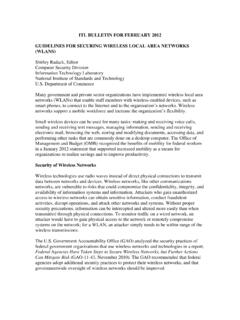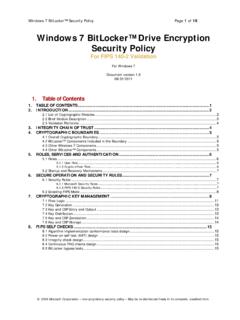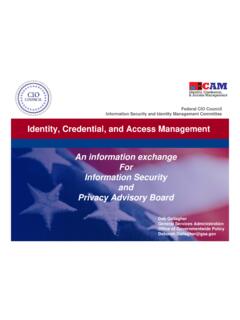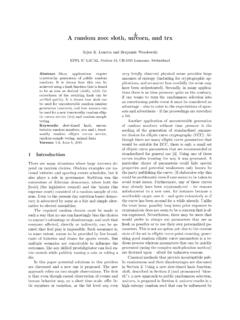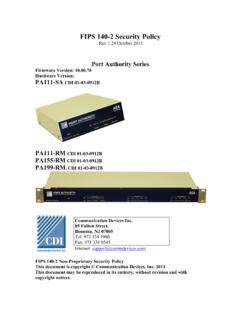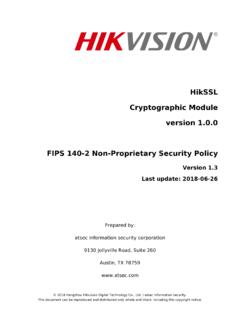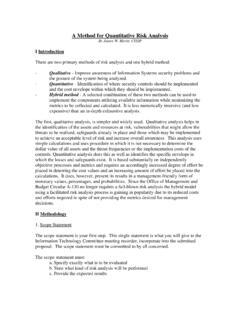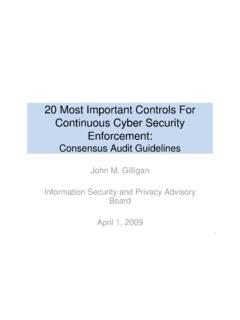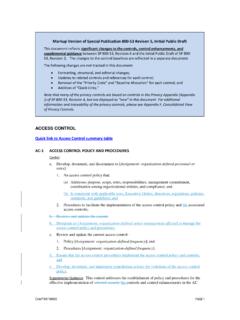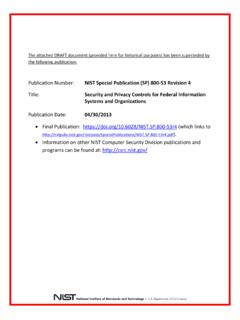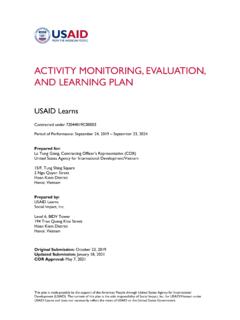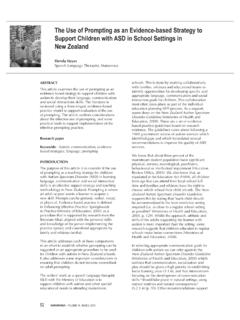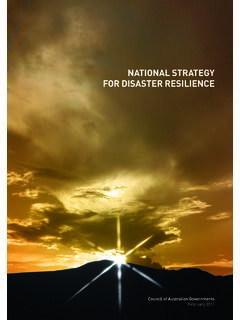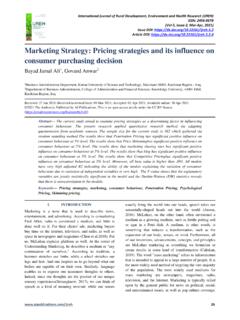Transcription of DoD Strategy for Operating in Cyberspace - NIST
1 DEPARTMENT OF DEFENSE Strategy FOR Operating IN Cyberspace JULY 2011 CONTENTS INTRODUCTION 1 STRATEGIC CONTEXT 2 FIVE STRATEGIC INITIATIVES Strategic Initiative 1: Treat Cyberspace as an operational domain to organize, train, and equip so that DoD can take full advantage of Cyberspace s potential 5 Strategic Initiative 2: Employ new defense Operating concepts to protect DoD networks and systems 6 Strategic Initiative 3: Partner with other government departments and agencies and the private sector to enable a whole-of-government cybersecurity Strategy 8 Strategic Initiative 4: Build robust relationships with allies and international partners to strengthen collective cybersecurity 9 Strategic Initiative 5: Leverage the nation s ingenuity through an exceptional cyber workforce and rapid technological innovation 10 CONCLUSION 13 Cybersecurity threats represent one of the most serious national security, public safety, and economic challenges we face as a nation.
2 - 2010 National Security Strategy INTRODUCTION Cyberspace is a defining feature of modern life. Individuals and communities worldwide connect, socialize, and organize themselves in and through Cyberspace . From 2000 to 2010, global Internet usage increased from 360 million to over 2 billion people. As Internet usage continues to expand, Cyberspace will become increasingly woven into the fabric of everyday life across the globe. and international businesses trade goods and services in Cyberspace , moving assets across the globe in seconds. In addition to facilitating trade in other sectors, Cyberspace is itself a key sector of the global economy. Cyberspace has become an incubator for new forms of entrepreneurship, advances in technology, the spread of free speech, and new social networks that drive our economy and reflect our principles.
3 The security and effective operation of critical infrastructure including energy, banking and finance, transportation, communication, and the Defense Industrial Base rely on Cyberspace , industrial control systems, and information technology that may be vulnerable to disruption or exploitation. Along with the rest of the government, the Department of Defense (DoD) depends on Cyberspace to function. It is difficult to overstate this reliance ; DoD operates over 15,000 networks and seven million computing devices across hundreds of installations in dozens of countries around the globe. DoD uses Cyberspace to enable its military, intelligence, and business operations, including the movement of personnel and material and the command and control of the full spectrum of military operations.
4 The Department and the nation have vulnerabilities in Cyberspace . Our reliance on Cyberspace stands in stark contrast to the inadequacy of our cybersecurity the security of the technologies that we use each day. Moreover, the continuing growth of networked systems, devices, and platforms means that Cyberspace is embedded into an increasing number of capabilities upon which DoD relies to complete its mission. Today, many foreign nations are working to exploit DoD unclassified and classified networks, and some foreign intelligence organizations have already acquired the capacity to disrupt elements of DoD s information infrastructure. Moreover, non-state actors increasingly threaten to penetrate and disrupt DoD networks and systems.
5 We recognize that there may be malicious activities on DoD networks and systems that we have not yet detected. DoD, working with its interagency and international partners, seeks to mitigate the risks posed to and allied Cyberspace capabilities, while protecting and respecting the principles of privacy and civil liberties, free expression, and innovation that have made Cyberspace an integral part of prosperity and security. How the Department leverages the opportunities of Cyberspace , while managing inherent uncertainties and reducing vulnerabilities, will significantly impact defensive readiness and national security for years to come. Department of Defense Strategy for Operating in Cyberspace 1 STRATEGIC CONTEXT There is no exaggerating our dependence on DoD s information networks for command and control of our forces, the intelligence and logistics on which they depend, and the weapons technologies we develop and field.
6 - 2010 Quadrennial Defense Review DoD s Strengths and Opportunities in Cyberspace As does the nation as a whole, DoD relies on a secure and reliable Cyberspace that protects fundamental freedoms, privacy, and the free flow of information. In support of both core commitments and national security, DoD has significant strengths and opportunities in Cyberspace . The military s ability to use Cyberspace for rapid communication and information sharing in support of operations is a critical enabler of DoD missions. More broadly, DoD s depth of knowledge in the global information and communications technology sector, including its cybersecurity expertise, provides the Department with strategic advantages in Cyberspace .
7 The quality of the United States human capital and knowledge base in both the public and private sectors provides DoD with a strong foundation on which to build current and future cyber capabilities. DoD has played a crucial role in building and leveraging the technological prowess of the private sector through investments in people, research, and technology. DoD will continue to embrace this spirit of entrepreneurship and work in partnership with these communities and institutions to succeed in its future Cyberspace activities. Given the dynamism of Cyberspace , nations must work together to defend their common interests and promote security. DoD s relationship with allies and international partners provides a strong foundation upon which to further international Cyberspace cooperation.
8 Continued international engagement, collective self -defense, and the establishment of international Cyberspace norms will also serve to strengthen Cyberspace for the benefit of all. Cyber Threats The very technologies that empower us to lead and create also empower those who would disrupt and destroy. - 2010 National Security Strategy The Internet was designed to be collaborative, rapidly expandable, and easily adaptable to technological innovation. Information flow took precedence over content integrity; identity authentication was less important than connectivity. The Internet s original designers could not have imagined the extent of its vital and growing role for DoD and its operations. The global scope of DoD networks and systems presents adversaries with broad opportunities for exploitation and attack.
9 Department of Defense Strategy for Operating in Cyberspace 2 Low barriers to entry for malicious cyber activity, including the widespread availability of hacking tools, mean that an individual or small group of determined cyber actors can potentially cause significant damage to both DoD and national and economic security. Small-scale technologies can have an impact disproportionate to their size; potential adversaries do not have to build expensive weapons systems to pose a significant threat to national security. In developing its Strategy for Operating in Cyberspace , DoD is focused on a number of central aspects of the cyber threat; these include external threat actors, insider threats, supply chain vulnerabilities, and threats to DoD s operational ability.
10 DoD must address vulnerabilities and the concerted efforts of both state and non-state actors to gain unauthorized access to its networks and systems. Foreign Cyberspace operations against public and private sector systems are increasing in number and sophistication. DoD networks are probed millions of times every day, and successful penetrations have led to the loss of thousands of files from networks and those of allies and industry partners. Moreover, this threat continues to evolve as evidence grows of adversaries focusing on the development of increasingly sophisticated and potentially dangerous capabilities. The potential for small groups to have an asymmetric impact in Cyberspace creates very real incentives for malicious activity. Beyond formal governmental activities, cyber criminals can control botnets with millions of infected hosts.
